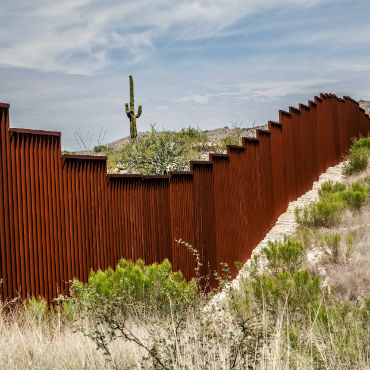DHS gets concrete on border wall prototypes

Tech will be an integral part of a proposed southern border wall, if the Customs and Border Protection prototypes are any indication.

The southern border wall promised by President Donald Trump is beginning to take shape with prototype contracts announced by Customs and Border Protection on Aug. 31.
Four construction firms were tapped by CBP to build the concrete-version prototypes that could become part of the overall effort to build a physical barrier along the southern U.S. border. The agency said more prototype contracts for "alternative materials" would be announced in the coming days. Those prototypes could include a variety of more innovative construction materials, which could be steel fencing or materials other than simple concrete.
The border wall's future funding and form are not set in concrete, however.
In a press conference announcing the awards to four construction firms, Ronald Vitiello, CBP acting deputy commissioner, said his agency was looking to see how the prototypes could complement and accommodate existing and possibly future border security technology.
"We are not just asking for a physical structure," Vitiello said. "We're asking for all the tools that help secure the border."
Later, he noted that CBP asked potential vendors to "pay attention … to how technology could be composited within these prototypes." Conduits, camera mounts and other tech accommodations, he said, were part of the companies' proposals, but the prototypes would not have the actual equipment in them.
Border agents, he said, want "detection, they want situational awareness, cameras and sensors" that allow them to work effectively. "All those things have to be combined in the proper mix to make it work."
Earlier in August, Trump threatened to shut down the government if the upcoming budget doesn't include $1.6 billion for initial wall construction. However, a Sept. 1 Washington Post report indicates that Trump administration officials have backed off a shutdown threat, at least as far as a short-term continuing resolution to keep the government open is concerned.
In the last few months, the president's initial call for a physical barrier that would span the entire southern border has morphed into a more pragmatic plan.
In that developing approach, technology would back, or even replace, the barrier in areas where experts, including former Department of Homeland Secretary and now White House Chief of Staff John Kelly, said a concrete physical barrier would be impractical.
The agency said in its Aug. 31 statement that it expects prototype construction to begin "in the fall."
The reinforced concrete barrier prototypes, which will 18-30 feet high and 30 feet long, will be built at Otay Mesa near San Diego, a hotbed of illegal cross-border activity, according to DHS.
The concrete prototype awards were delayed a month as the Government Accountability Office reviewed bid protests on prototypes. It dismissed those protests the week of Aug. 24, paving the way for the contract awards.
However, CBP noted that even though the prototype contracts have been awarded, unsuccessful bidders would have new opportunities to file protests, which could further delay construction.
Each award is worth roughly $500,000. The money will come from an initial $20 million DHS was authorized to draw from other sources earlier this year.


